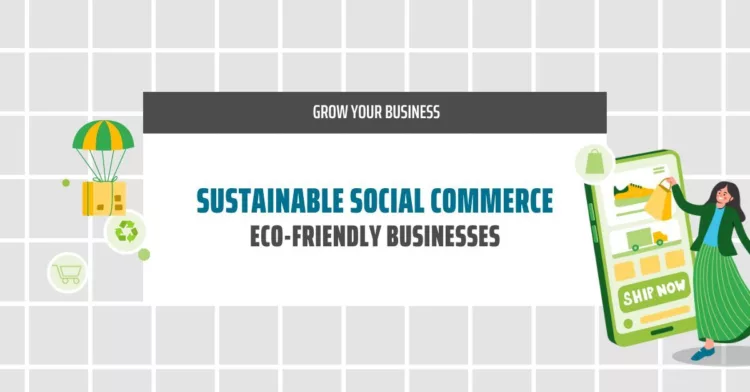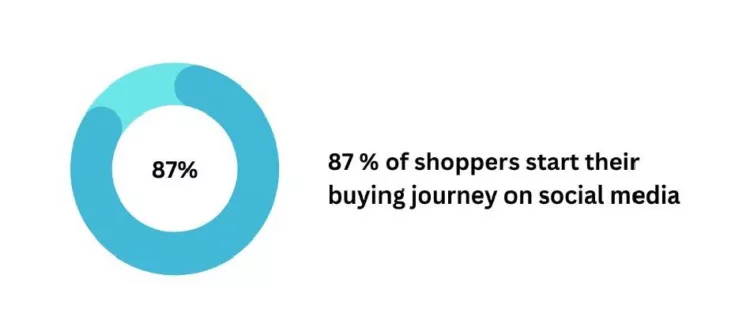Social Commerce Meets Sustainability: Eco-Friendly Businesses

Discover how social commerce and eco-friendly choices can come together to create sustainable brands. Integrate ethical practices and educate your audience using engaging content and genuine storytelling!
Embrace the power of social media and storytelling to create a profitable business while contributing to a healthier planet.
Social media has completely changed the way we communicate. But what if we told you that it is also revolutionizing how we shop?
The e-commerce landscape is expanding rapidly. Every year people are spending more and more time and money on social media platforms buying and sharing products.
This presents an amazing opportunity for businesses to leverage social commerce to build sustainable brands using eco-friendly practices and promote this culture.
Imagine a world where every purchase you make not only brings you joy but also contributes to a healthier planet!
Let’s dive in to see how these concepts can go hand-in-hand to build environmentally conscious businesses.
What is social commerce?
You may hear the term “social commerce” thrown around quite often these days but it isn’t just a buzzword!

Social commerce is the practice of selling products and services through social media platforms. The idea is to host the entire shopping journey from discovering a product to the final transaction on social media.
Over 87% of shoppers start their search with social media when they are looking to purchase something.
This presents an amazing opportunity for brands to funnel potential customers in to sell their products.
What is a sustainable business?
Now, let’s talk sustainability! It can often feel like a trend but the reality is that is a necessity.
A sustainable business isn’t only concerned about the profits they are making today; it also aims to secure a better future by using eco-friendly practices. In a world where environmental issues have become a topic of concern, these businesses play a very important role.
And guess what? Consumers are on board!
Studies have shown that many buyers are open to changing their buying habits if it means that they are consuming sustainable products.
Integrating eco-friendly practices in social commerce
Picture this: you’re scrolling one of your socials and you come across an ad. But this isn’t just any ad - it showcases a product that isn’t just an amazing product but is also proudly eco-friendly.
To build a strong brand identity around sustainability businesses need to use social commerce to nurture communities of eco-conscious customers. Some of the key things to consider when doing so are:
Sustainable Products
Brands are transforming their identity and products by embracing eco-friendly practices. How? By infusing their creations with features that speak to a greener future:
- Organic and Sustainable Materials: Imagine slipping into a dress made from organic cotton or carrying a bag crafted from recycled materials. These are the stories brands are weaving into their products, making them not just stylish but sustainable too.
- Recyclable and Biodegradable Packaging: The packaging that once cluttered landfills is now evolving. Brands are using materials that can be recycled or naturally broken down, reducing the burden on our planet.
Educating Consumers About Impact
Social commerce isn't just about transactions; it's about conversations. Brands are becoming educators, helping consumers understand the ripple effects of their choices:
- Transparent Supply Chains: By sharing insights into sourcing and production processes, brands can demystify their journey. This allows consumers to make informed choices that align with their values.
- Environmental Footprint: Social media platforms are providing a stage to showcase the environmental impact of products. From reduced carbon emissions to water conservation, consumers get a snapshot of the positive change they can drive.
Empowering Thoughtful Decisions
The power of choice lies with the consumer, and social commerce platforms are making eco-friendly options accessible:
- Visible Options: Whether it's a filter for eco-friendly products or a dedicated section, platforms are ensuring that sustainable choices stand out.
- Convenience and Ease: With a few clicks, consumers can embrace sustainability. From biodegradable cosmetics to energy-efficient gadgets, the path to greener living is simpler than ever.
Building a sustainable social commerce brand
Creating a sustainable social commerce brand is more than selling products. It’s about crafting a meaningful narrative that incorporates the brand’s eco-friendly approach to speak to a certain audience.
Some of the key strategies businesses can focus on are:
- Authentic Storytelling: As a brand, it is important to convey your commitment to sustainability to your audience. Focussing on building genuine connections through your marketing efforts with your customers can pay massive dividends.
Sharing the journey of how products are made, the challenges faced, and the positive impact they generate can help build trust and loyalty.
- Engaging Content: Incorporating sustainability into the content strategy is essential. This can include sharing behind-the-scenes peeks of sustainable practices and even speaking on challenges transparently.
Engaging content not only educates but also creates a sense of community among like-minded individuals.
- Collaborations with Influencers: Partnering with influencers who have built solid brands around sustainability can amplify your brand's message.
Influencers can create relatable content, showcasing how they use eco-friendly products in their daily lives, and encouraging their followers to do the same.
- Loyalty Programs: Rewarding customers for their commitment to sustainability can foster brand loyalty.
Loyalty programs that offer incentives for repeat purchases of eco-friendly products or for referring friends can encourage sustained engagement.
Major challenges
Combining social commerce and sustainability holds great potential for any brand. But it does present some challenges:
Greenwashing concerts: Some business have grossly overstated their efforts toward sustainability to attract eco-conscious customers and create a better brand perception. This has led to many consumers being skeptical of the image certain brands try to portray.
To overcome this distrust brands need to ensure that their claims are genuine and can be backed up with facts.
Higher costs: For a business, choosing sustainable business practices can result in higher production costs, which may reflect in the prices of their product. Maintaining a healthy balance between affordability and sustainability is crucial.
Limited Awareness: Not all consumers are aware of the environmental challenges we are facing or care enough to pay attention. Businesses need to invest in good educational content that can help raise awareness and help their audience understand the impact of their purchases.
Supply Chain Complexities: Sourcing products that are ethically produced with sustainable materials can be challenging and expensive. Navigating complex supply chains is something brands need to spend more resources on to maintain their commitment to sustainability.
Final Thoughts
The combination of social commerce and sustainability can be extremely fruitful for businesses that are genuinely putting effort into making eco-friendly choices.
Social media platforms provide a unique opportunity to tell stories and raise awareness about sustainability as well as your brand’s commitment to the cause. If done correctly, it can help you educate your consumers as well as attract a whole new set of people toward your brand.
There is a large shift in culture towards greener practices and businesses that care can make the most of this opportunity to grow their business and help save the planet!
Frequently Asked Questions
What is an example of social e-commerce?
An example of social e-commerce is when a brand sets up a shop on a social media platform like Instagram or Facebook. And allows users to browse, select, and purchase products without leaving the app.
What is the difference between e-commerce and social commerce?
E-commerce refers to online buying and selling, often through dedicated websites. Whereas, social commerce, integrates shopping features directly within social media platforms, making the shopping experience more seamless and interactive.
What is sustainable e-commerce?
Sustainable e-commerce involves online businesses that adopt eco-friendly practices throughout their operations. This includes sourcing materials, packaging, and distribution, aiming to reduce their environmental impact and promote responsible consumption.
Author Bio
Utkarsh Anand is the founder of The Lamest Blog, and a marketer who leverages his diverse skill set to optimize websites, craft engaging copy, and drive organic traffic.
Price change for nine TLDs from 1st January 2024
How to build an online community for businesses and grow it
Related articles:
